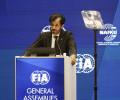PROVING GROUND
The FIA’s efforts to boost the sustainability of motor sport are being felt in every area of competition, from the organisations involved in staging events to the circuits on which we race and beyond…

It’s March 2019 at the Geneva Motor Show. The promoters from the FIA’s major championships – Formula One, World Rally, World Rallycross, World Endurance, Formula E and Karting – have gathered at the FIA’s invitation to discuss one issue: motor sport’s relevance and sustainability.
The one thing they all agree on is that the sport needs to be proactive in proving its environmental credentials.
“They sat around the table for a two-hour workshop, and the subject was about making motor sport more sustainable and relevant for the fans, for the partners, for the industry,” says Marina Tailpied, who is in charge of the Sustainability Programme for Sport at the FIA. “There was overall support and enthusiasm from them all, and the general feeling was that the FIA should pursue a stricter policy in this area.”
This was music to the ears of Tailpied, who coordinates the FIA environmental accreditation process, which helps motor sport stakeholders measure, improve and be recognised for their environmental performance.
It is one of the first accreditation programmes to have been developed specifically for any sport and it enables all motor sport stakeholders to align their performance to the highest level of environmental standards. Those that sign up are rated on three levels of performance: one-star, two-star and three-star, measuring their sustainability achievement and providing a benchmark against how they can improve for the future.
The project follows a broad range of international standards having been created and then guided by Even Wiger, the FIA Sustainability and Environmental Advisor, who is an International Organization for Standards (ISO) certified auditor. Wiger has long experience in this area, having audited and implemented environmental management programmes across both the motor sport and construction sectors.
In the few years since the programme was launched, the FIA has already awarded the maximum three-star accreditation to National Sporting Authorities (ASNs), motor racing teams, promoters, circuits, events and suppliers across the sport. The FIA’s long-term objective is to bring all FIA stakeholders on board, through the gradual three-level approach, with the aim to raise collective awareness and improve the overall environmental performance in the motor sport ecosystem.
One of the most successful series has been the FIA World Rally Championship (WRC), which is the first to stipulate that all events must achieve three-star environmental accreditation if they are to stay on the calendar. This has created a unique situation where even prospective events are seeking to prove their environmental credentials before they are part of the series.
Rally Kenya has set the benchmark by being the first WRC candidate event to actively apply for accreditation before being confirmed on the WRC calendar, and this is a significant demonstration of progress for the accreditation scheme, according to Wiger. “Usually an event gets the confirmation from the FIA that it will be on the next season’s calendar and then we reach out to them. But in this case, Kenya’s promoters took a proactive approach to ensure they are fully aligned with the regulations ahead of the first event.”
Kenya will potentially join a host of other WRC events that have already achieved accreditation, between them launching a wide range of sustainability initiatives from waste management programmes and carbon neutral operations to local awareness campaigns and healthcare projects.
Rally Sweden, for instance, has implemented an ambitious environmental strategy called ‘Vision Zero’, which aims to minimise waste through various methods including the reduction of food waste and the use of recyclable plastic items, and to reduce emissions by promoting transportation with low-carbon footprint vehicles and the use of renewable energy. This ‘Vision Zero’ approach is also coupled with the event’s safety strategy – combining sustainability and safety is expected to optimise returns.
Among other events, Rally Australia has become the first carbon neutral event on the calendar. Rally México has implemented recycling initiatives by producing shoes made out of plastic bottles, along with a ‘Health Rally’ initiative that provides healthcare for smaller cities around the stage routes. Rally Argentina has implemented a waste collection effort incentive for spectators, as have Rally de Portugal and Rally de España, which both have a progressive waste management programme.
Elsewhere, Rally Italia Sardegna has been raising awareness on environmental sustainability through schools by teaching children about waste management and recycling methods, while Rally Finland has made steady progress by appointing its Rally Managing Director as an Environmental Champion.
FORMULA E-CO
The Accreditation Programme is not just limited to racing events, but also applies to teams and entire championships. McLaren was the first team (and currently the only F1 team) to have achieved accreditation, while the Formula One Group, F1’s promoter, is examining the potential to benchmark its environmental credentials.
Perhaps unsurprisingly the ABB FIA Formula E Championship, which uses electric-powered cars, is leading the way, with its promoter being to date the only international promoter to achieve a three-star certification from the FIA alongside the ISO 20121 certification, the highest for green events.
This has extended to the Formula E teams, as Mahindra Racing renewed its two-star accreditation at the start of the year, having joined the programme in 2016. The team now plans to be carbon neutral by 2020 along with achieving a three-star rating.
“We take sustainability and environmental issues seriously at the team, and we are a strong believer that education and information are at the core of the challenges we are facing globally,” says Claudio Corradini, Mahindra Sustainability and Environmental Manager. “As a team we work hard to improve our sustainability and fight pollution in our everyday lives, both at work and at home.”
Other Formula E teams are keen to follow suit, with DS Techeetah announcing in May this year that it will be joining the programme to work on its carbon footprint, with the support and expertise of leading environment and mobility companies, in order to achieve carbon neutrality of its operations. An FIA meeting with several Formula E team principals and managers on the margins of the Bern E-Prix has secured the engagement of other FE teams in the process, and this is an encouraging sign for the championship.
“It is still a voluntary process in the sense that it is not yet mandatory to join, but in parallel we wish to make it mandatory in the near future through the championship’s sporting regulations,” says Tailpied. “For Formula E it would send a positive signal that the teams are doing it themselves even before it’s a regulation.”
MAXIMUM IMPACT
One of the key things the FIA Environment and Sustainability Commission is keen to do is get more F1 circuits involved with the accreditation programme, because of the number of events they encompass throughout a year which can achieve the FIA’s ‘maximum impact’ targets.
Currently in F1 only the Circuit de Catalunya has a three-star accreditation, but there are plans to add more with French Grand Prix host Paul Ricard circuit due to submit a three-star application later this year, and other circuits including Zandvoort, which is returning to the F1 calendar in 2020, being in contact with the FIA’s Sustainability Department.
“If you look at Circuit de Catalunya, which is the only F1 circuit to be accredited on the FIA programme, it doesn’t only serve for F1 once a year,” says Tailpied. “it serves for other major racing events, including non-FIA ones such as MotoGP, which means that the environmental management system in place for the F1 weekend actually runs through the entire year.”
This is why it is important for the FIA to target these circuits as it brings in a much wider range of other events and activities, potentially not limited to motor sport.
This is perhaps the scope for the future of the FIA Environmental Accreditation Programme as the Federation looks to make it more recognised by governing bodies worldwide. This could potentially be something that gets implemented into other forms of motor sport including motorcycling, which is governed by the FIM.
“We have a very positive dialogue with the FIM on this topic, and it seems that the FIA and the FIM could achieve positive synergies by using a common set of guidelines,” says Tailpied.
“They have MotoGP stars acting as ambassadors of their ‘Ride Green’ campaign, they are very strong in communications, they also send environmental ‘stewards’ to their events, but they don’t have the specially tailored, three-level accreditation system that we have,” adds Tailpied. “In that sense, the FIA is leading the way, not just in motor sport but among all sports governing bodies.”
Improving performance is in the FIA’s DNA. As motor sport becomes greener on the track, it is important that the message is translated off-track into a collective effort with the continuous aim to improve environmental performance. The FIA, through its Sustainability Programme, has laid the groundwork for an international standard that is already seeing an impact across motor sport, and which can only grow with more stakeholders looking to demonstrate their commitment to reducing their carbon footprint.
FULL EDITION OF AUTO#27 TO READ HERE

 Facebook
Facebook Twitter
Twitter






